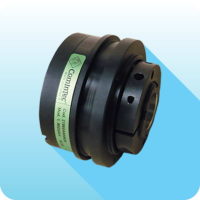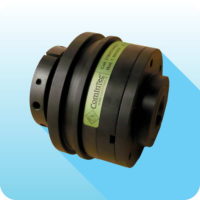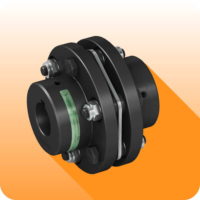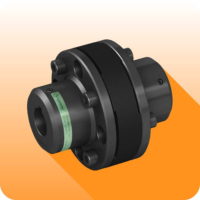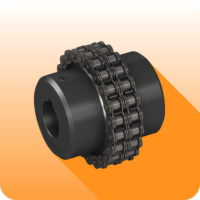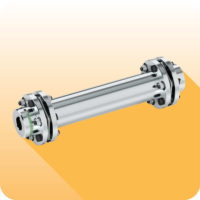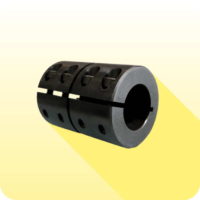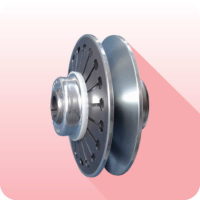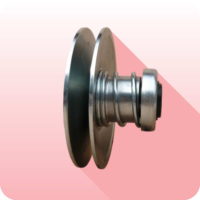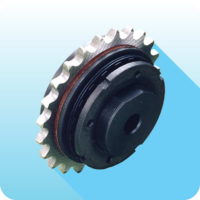
PULEGGE VARIABILI - SLITTE PORTA MOTORE: introduzione
VARIABLE SPEED PULLEYS - MOTOR SLIDE BASES: introduction
4
Dove -
:
Where
C
f
P
n
r
ω
2max
ω
2min
=有限公司ppia - torque
[Nm]
= fattore di servizio -
service factor
= potenza applicata -
applied power [Kw]
= numero di giri -
e
revolutions per minut
[rpm]
= rapporto di variazione -
variation ratio
= velocità angolare massima dell'albero condotto - Max angular speed of the driven shaft
[rad/s]
= velocità angolare minima dell'albero condotto - Min angular speed of the driven shaft
[rad/s]
r=
ω
2 max
ω
2 max
=
n
max
n
min
C
=
nom
n
9550
f
P
•
•
Dove -
:
Where
v
i
ω1
ω2
d2
D2
n
= velocità periferica -
peripheral speed [m/s]
= rapporto di trasmissione -
transmission ratio
= velocità angolare puleggia motrice -
driving pulleys angular speed [rad/s]
= velocità angolare puleggia condotta -
driven pulleys angular speed [rad/s]
= diametro esterno pulegga motrice -
driving pulley external diameter [m]
= diametro esterno pulegga motrice -
driven pulley external diameter [m]
= numero di giri -
e
revolutions per minut
[rpm]
i=
ω
1
ω
2
=
D
2
d
1
v=
ω
1
=
2
D
2
d
1
ω
2
2
ω =
2 n
p
60
2) Choose the family of pulleys (with fixed or variable distance
between centres) most suitable to the type of application
required, also on the basis of the necessary variation ratio
(see point 1), the available space, and the model characteristics.
3) Establish the torque to be transmitted.
For a correct functioning of the expandable pulley, a regular speed
variation, maximum variator performance and maximum life of
the transmission belt, it is necessary to dimension the variator,
观察几个简单的基本规则:
1) Identify the speed of the engine shaft and the necessary
variation ratio.
Per un corretto funzionamento della puleggia espansibile, una
regolare variazione della velocità, il massimo rendimento del
variatore e la massima durata della cinghia di trasmissione, è
necessario dimensionare il variatore, rispettando alcune semplici
regole fondamentali:
1) individuare la velocità dell'albero motore e il rapporto di
variazione necessario.
2)
Effetuare la scelta della famiglia di pulegge (ad interasse fisso o
variabile), più adatta al tipo di applicazione richiesto, anche in base
al rapporto di variazione necessario (vedi pt.1), agli spazi disponibili
e alle caratteristiche del modello.
3) Stabilire la coppia da trasmettere.
4) Choose the size on the basis of the dimension of the shafts and
the torque to be transmitted; take also into account the service
coefficient appropriate for the transmission characteristic (see pt 3).
5) Check that the peripheral speed of the belt is between 4 and 30 m/s.
4) Scegliere la grandezza in base alla dimensione degli alberi e alla
coppia da trasmettere, tenendo conto anche del coefficiente di
servizio adeguato alla caratteristica della trasmissione (vedi pt.3).
5) verificare che la velocità periferica della cinghia
sia compresa tra
i 4 e 30 m/s.
DIMENSIONAMENTO DELLA TRASMISSIONE -
TRANSMISSION DIMENSIONING
Potenza trasmissibile - T
ransmissible po
wer
[Kw]
0
2
4
6
8
10
12
14
16
18
20
22
24
26
28
30
32
34
0
1
2
3
4
5
6
7
8
9
Velocità periferica - peripheral speed
[m/s]
Fattore di servizio - Service factor " f "
Tipo di carico - Type of load
Uniforme con bassa inerzia - Uniform with low inertia
Irregolare pulsante con media inerzia
Irregular pulsating with average inertia
Molto irregolare con frequenti avviamenti e grosse masse d'inerzia
Very irregular with frequent starting and big inertia masses
0 - 6
ore - hours
6 - 12
ore - hours
12 - 24
ore - hours
1
1,2
1,5
1,45
1,7
2
1,7
1,9
2,5
在基地真主安拉velocita angolare德拉cinghia (vediformula
pt.1), ricavare nel grafico la potenza trasmissibile.
On the basis of the angular speed of the belt (see
formula in point 1), obtain the transmissible power on
the chart.




